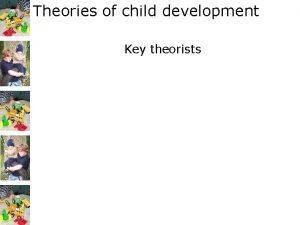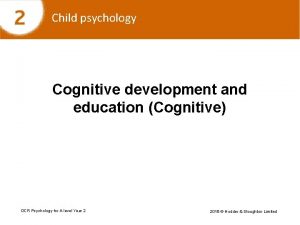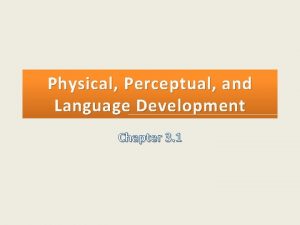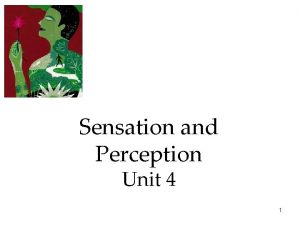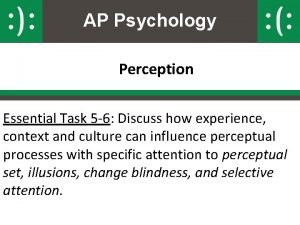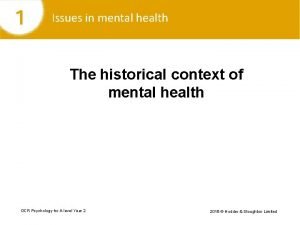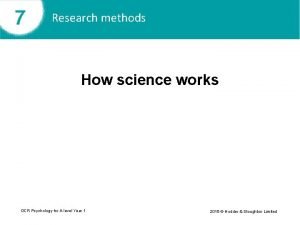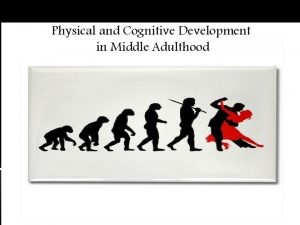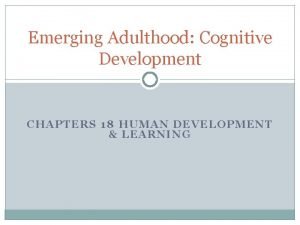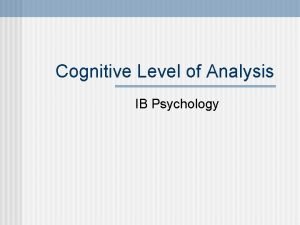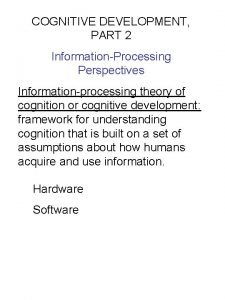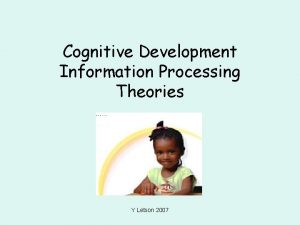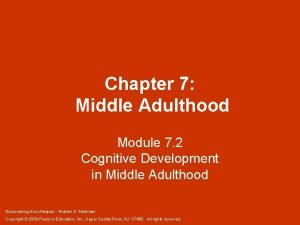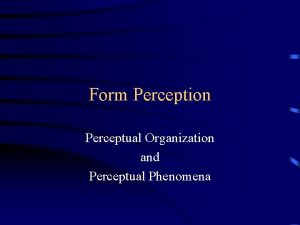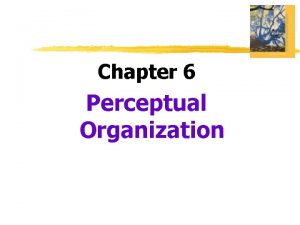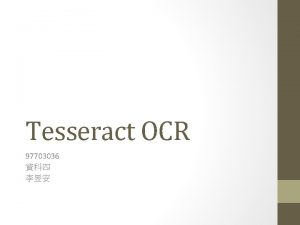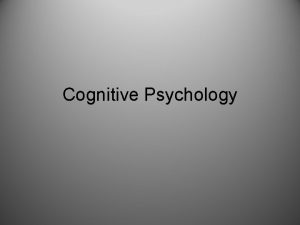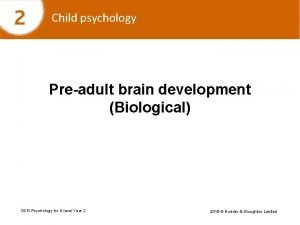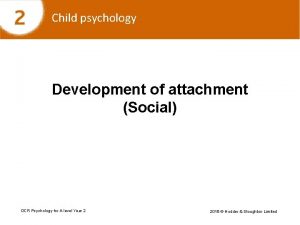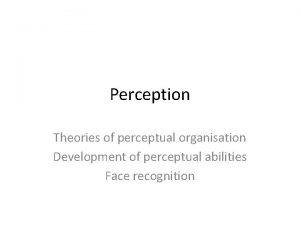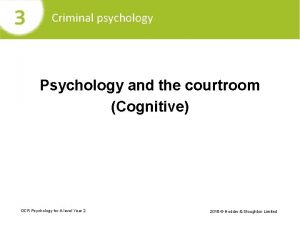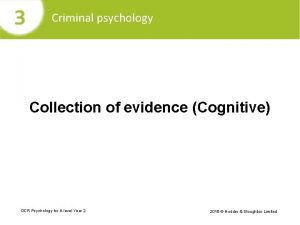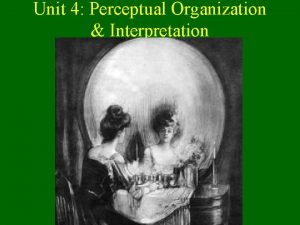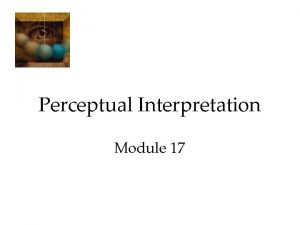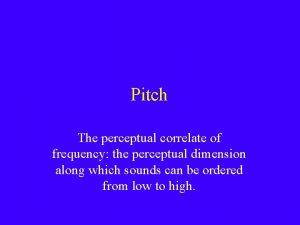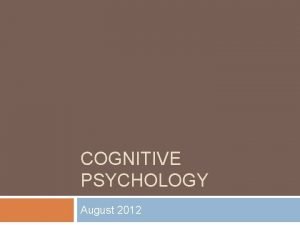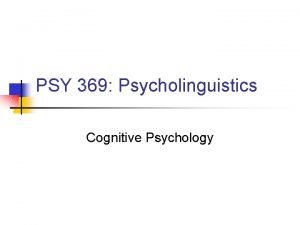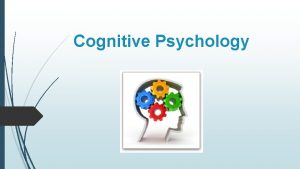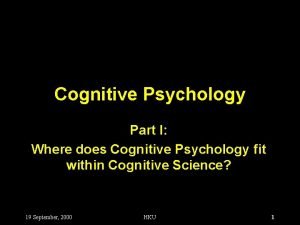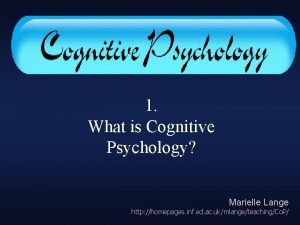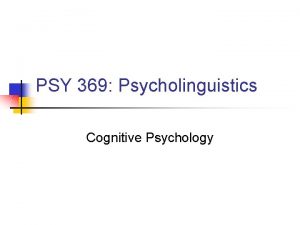Child psychology Perceptual development Cognitive OCR Psychology for


























- Slides: 26

Child psychology Perceptual development (Cognitive) OCR Psychology for A level Year 2 2016 © Hodder & Stoughton Limited

Child psychology Background OCR Psychology for A level Year 2 2016 © Hodder & Stoughton Limited

Child psychology Cognition • • Turning the perception of the world around us into cognition is a remarkable act that we often take for granted. This process involves taking external stimuli in the world, processing it through the biology of our bodies and then turning it into thoughts that happen in our brain. • Auditory perception starts first with hearing a noise that our eardrums receive, which is then processed into information (for example, recognising the noise of a car). • Tactile perception is feeling different textures and materials through our fingertips, which is then translated into a thought process (e. g. recognising silk). • Visual perception is taking information that enters our pupils and being able to recognise objects, colours and depth. OCR Psychology for A level Year 2 2016 © Hodder & Stoughton Limited

Child psychology Perceptual development in children • When first born, babies find it difficult to make sense of the world around them; however, there are some things they recognise quickly. • If we measure a baby’s interest by how long it looks at an object, newborn babies tend to be more interested when they are presented with new objects rather than objects they have already encountered. • Even if the new object is similar (e. g. a rectangle after a square) then the child still finds this interesting. • This could mean that newborn babies can immediately tell the difference when they encounter a new object. OCR Psychology for A level Year 2 2016 © Hodder & Stoughton Limited

Child psychology Pattern perception • When shown patterns, infants prefer complex patterns compared to simple ones. This indicates babies can tell the difference between them (Fantz 1963). • Newborn babies (as low as under five days old) were also more interested in patterns that resembled human faces. This suggests a biological ability to perceive and recognise faces. OCR Psychology for A level Year 2 2016 © Hodder & Stoughton Limited

Child psychology Face recognition • Other research has also found that babies can pick out faces from a variety of other images. In particular, babies are good at recognising their mother’s face, being able to choose it from other female faces. There are limits to this, however. Babies need to see the hairline of the mother to be able to recognise her accurately and they cannot recognise the mother if they only see a profile (her face from the side). • After 5 months, babies can recognise facial expressions – differentiating between expressions of smiles and fear and even being able to judge the intensity of a smile. • At 7 months, babies prefer to choose faces that are the right way up instead of upside down, suggesting that as the child learns to sit up correctly they are used to seeing the world the right way round. • At 9 months, babies can differentiate between genders but only if the face has stereotypical features of that gender (e. g. long hair for women). • Children who have been raised by male caregivers are better at picking out male faces, suggesting that perception develops with familiarity of what is around them. OCR Psychology for A level Year 2 2016 © Hodder & Stoughton Limited

Child psychology Draw a timeline to show children’s abilities at different ages OCR Psychology for A level Year 2 2016 © Hodder & Stoughton Limited

Child psychology Depth perception • How good are babies at recognising depth? • As adults we can tell when objects are further away by judging things like the height of the object, the relative size of the object (i. e. objects further away appear smaller) and superimposition (when one object appears in front of another). • When do we develop this ability, though? • Some researchers have found that 6 -week-old infants will display fear when they are lowered into the deep end of a visual cliff (see key research) indicating they can judge distance and depth. OCR Psychology for A level Year 2 2016 © Hodder & Stoughton Limited

Child psychology Depth perception • • • When studying the development of perception, one key question psychologists want to know is if perceptual development is innate or learned from the environment (nature vs. nurture). Fantz in the 1950 s measured a child’s interest by timing how long children would stare at stimuli for. The longer they looked, the more interested they were in a stimuli. The advantages of this method are that the experimenter can only see where the child is looking and doesn’t necessarily know what the child is looking at (eliminating researcher bias). It is also useful, as very small children can be used as they need no training or instructions. Video recordings can also be taken of where the child is looking, so independent researchers can verify the timings of where the child looks (increasing inter-rater reliability). The disadvantage of this method is that we can only assume that if the child is looking at the stimulus she/he is interested in it. They might be looking in that direction for any number of reasons. OCR Psychology for A level Year 2 2016 © Hodder & Stoughton Limited

Child psychology Using physiological methods • • Physiological measures can be used to measure the interest a child has in a stimulus as well. This can come in the form of brain scans, blood pressure or measuring heart rates (e. g. slower heart rates often mean interest while faster heart rates mean excitement). These methods are as good as machines at giving an unbiased, objective measures. Rather than a nominal measure of ‘Is this child looking at the stimulus or not? ’, measuring brain activity or heart rate can give more detailed ordinal data and allows questions like ‘How interested is this child in this stimulus? ’ Additional insight into different processing strategies can also be achieved through use of technical equipment. However, equipment like this often needs a person to be still and this is notoriously difficult to achieve with babies. Exposing infants to equipment that is noisy and frightening is unethical. OCR Psychology for A level Year 2 2016 © Hodder & Stoughton Limited

Child psychology Key research: Gibson and Walk (1960) The visual cliff OCR Psychology for A level Year 2 2016 © Hodder & Stoughton Limited

Child psychology Background The researchers were interested in why young children and animals seem to know immediately not to fall from high places. Is this ability to judge depth due to nature or is it learned through nurture? Aim To document if young animals and children were able to perceive depth and know not to walk off a ‘visual’ cliff. OCR Psychology for A level Year 2 2016 © Hodder & Stoughton Limited

Child psychology Sample – Human study 36 children aged 6 to 14 months. Procedure The child is placed at the centre of a ‘visual’ cliff. The mother can either stand on the shallow side and call the baby to her or on the deep side and call the baby to her. OCR Psychology for A level Year 2 2016 © Hodder & Stoughton Limited

Child psychology Results • 100% of children moved to the shallow side of the cliff to get to their mother. • 11% of children moved to the deep side of the cliff to get to their mother. • When first placed on the cliff, children would look over the cliff edge. Some tested the glass for solidarity but didn’t cross. • When the mother called to them from the deep side of the cliff, the most common reaction was to crawl away from the mother. Others would sit and cry on the shallow side. OCR Psychology for A level Year 2 2016 © Hodder & Stoughton Limited

Child psychology Conclusion • The results showed that children can perceive depth as they appear to be cognitively aware of the edge of the cliff. • However, this study only tested children when they had started to crawl so you cannot tell for certain whether this depth perception is innate or learned. OCR Psychology for A level Year 2 2016 © Hodder & Stoughton Limited

Child psychology Make notes and include pictures of the animals Findings Conclusions OCR Psychology for A level Year 2 2016 © Hodder & Stoughton Limited

Child psychology Animal studies • • • This visual cliff study was also used on baby animals, including chicks, goats, lambs, kittens, rats and turtles. The chicks would never cross the cliff. Lambs and goats would not cross the deep side (even less than a day after being born). If forced on the deep side, their legs would go limp. When the cliff drop was made smaller (30 cm) the goats would cross the deep end. At 4 weeks old the kittens wouldn’t cross the deep end, but kittens raised in darkness would walk on either side. Once exposed to light, however, these kittens would within a week avoid the deep side of the cliff. The rats used their whiskers to tell there was glass on the deep side of the cliff so would cross it. To avoid this, the shallow end was slightly raised so the rats couldn’t reach the glass with their whiskers. Once this was done 95% wouldn’t cross the deep side. Rats raised in darkness also avoided the deep side. Turtles did not mind either the shallow or deep side. Can you explain why this was unique to turtles? OCR Psychology for A level Year 2 2016 © Hodder & Stoughton Limited

Child psychology Discussion • Although the animal studies seem to show an innate ability to develop the perception of depth, you cannot completely generalise to humans. • Gibson and Walk do argue that enough animals were tested to make a fair deduction into human perceptual development. • While it is not ethical to raise children in darkness, the researchers suggest that further study is completed on kittens raised in the dark, and how they change when exposed to light. OCR Psychology for A level Year 2 2016 © Hodder & Stoughton Limited

Child psychology Using animals to study perceptual development • Research into animals is often used when it is unethical to carry out certain experiments on humans. • This gives researchers a much greater amount of control on studies to make more valid conclusions with. • However, a difficulty with research on animals is the question of whether or not you can generalise data from animals on humans. • One way in which researchers have tested visual perceptual development on animals is by controlling how much light animals are exposed to at birth. • WARNING – the following research on animals may be considered upsetting for some. OCR Psychology for A level Year 2 2016 © Hodder & Stoughton Limited

Child psychology Examples of animal research • Spalding kept baby chickens in black sacks with no light. When released the chicks could run to their mother avoiding obstacles; this implies that the chicks had an innate ability to perceive their environment from birth. • Lashley and Russell (1934) found a similar finding when they noticed that rats that had been kept in the dark for three months put more effort into jumping over large gaps than smaller gaps (once again implying that these rats had a natural ability to perceive their surroundings). • Some researchers even went as far as sewing the eyelids of kittens shut. This made them blind, but able to interact with the environment around them. The kittens were kept like this for a time and then their eyes were opened again. • If the kittens could navigate their environment it showed they had innate perceptual development (nature), if they couldn’t then it revealed that some perception is normally learned from the environment (nurture). OCR Psychology for A level Year 2 2016 © Hodder & Stoughton Limited

Child psychology Further examples of animal research • Riesen (1965) compared three chimps: Debi (kept in darkness for from birth until 7 months, Kova (who spent 1. 5 hours a day in light and the rest in darkness) and Lad (kept in normal light). • Lad showed no anomalies in his perceptual development. • Debi had retinal damage. • Kova showed no damage but her perceptual development was underdeveloped. • What does this add to our understanding of perceptual development? OCR Psychology for A level Year 2 2016 © Hodder & Stoughton Limited

Child psychology Sperry (1943) • Sperry looked at Salamanders. Using surgery he turned their eyes upside down by rotating the optic nerve. • The salamanders now saw back to front and upside down. • Understandably the salamanders found it difficult to perceive, as their world was now very different. • No amount of training could change their response, indicating that their perceptual development was innate. OCR Psychology for A level Year 2 2016 © Hodder & Stoughton Limited

Child psychology Application: A play strategy to develop perception OCR Psychology for A level Year 2 2016 © Hodder & Stoughton Limited

Child psychology What is the application? • One of the main findings from this section is that although some perception is innate, it still develops more strongly with interaction with the environment. • The application of this is that providing children with the right environment can aid their perception development. OCR Psychology for A level Year 2 2016 © Hodder & Stoughton Limited

Child psychology Playing with perception • A good way to create a good environment for babies is to use toys that stimulate the child’s perceptive abilities. • Games such as sound bingo, where the child identifies animals by the sound they make, help to attune the infant’s auditory perception. • Tactile toys made from different materials (shiny, soft, wooden, etc. ) aid tactile perception. • Colourful toys with objects and letters as well as shape sorting games all contribute to visual perception development. • Baby gyms have a combination of these senses but also might include toys on a string made to test the infant’s reaching and grasping ability (as well as their depth perception) and even mirrors can aid a child’s self-concept of who they are. OCR Psychology for A level Year 2 2016 © Hodder & Stoughton Limited

Child psychology Research toys and find ones that you think we promote perceptual development Explain how it will develop babies OCR Psychology for A level Year 2 2016 © Hodder & Stoughton Limited
 What is gesell's theory of development
What is gesell's theory of development Cognitive theory child development
Cognitive theory child development Education cognitive development
Education cognitive development Cognitive and non cognitive religious language
Cognitive and non cognitive religious language Physical perceptual and language development
Physical perceptual and language development Internally programmed growth of a child
Internally programmed growth of a child Motivation perceptual set
Motivation perceptual set Perceptual set psychology definition
Perceptual set psychology definition Phi phenomenon psychology definition
Phi phenomenon psychology definition Perceptual set ap psychology
Perceptual set ap psychology Ocr level 6 diploma in career guidance and development
Ocr level 6 diploma in career guidance and development Historical views of mental illness psychology ocr
Historical views of mental illness psychology ocr Ocr psychology research methods
Ocr psychology research methods 전위 순회
전위 순회 Cognitive development for middle adulthood
Cognitive development for middle adulthood Physical development in adulthood
Physical development in adulthood Cognitive development in middle and late childhood
Cognitive development in middle and late childhood Ap psych schema
Ap psych schema Late adulthood cognitive development
Late adulthood cognitive development Cognitive learning theory by jerome bruner
Cognitive learning theory by jerome bruner Robert siegler
Robert siegler Emerging adulthood cognitive development
Emerging adulthood cognitive development Cognitive levels of development
Cognitive levels of development Cognitive development characteristics
Cognitive development characteristics Information processing theory of cognitive development
Information processing theory of cognitive development Information processing theory of cognitive development
Information processing theory of cognitive development Cognitive development middle adulthood
Cognitive development middle adulthood
